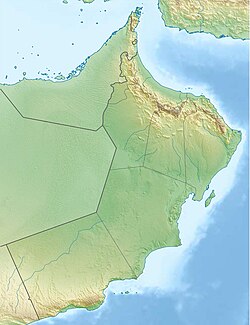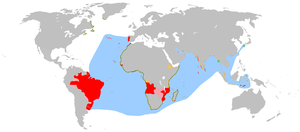Qalhat: Difference between revisions
Removing notable tag, it is notable. |
Marcocapelle (talk | contribs) →References: removed grandparent category of Category:Archaeological sites in Oman |
||
| (45 intermediate revisions by 33 users not shown) | |||
| Line 1: | Line 1: | ||
{{Infobox settlement |
|||
{{primary sources|date=March 2009}} |
|||
| name = Qalhāt |
|||
| native_name = {{lang-ar|قلهات}} |
|||
| settlement_type = [[Village]] |
|||
| image_skyline = Qalhat flickr01.jpg |
|||
| coordinates = {{coord|22|41|58|N|59|22|10|E|display=inline}} |
|||
| subdivision_type = [[Country]] |
|||
| subdivision_name = [[Oman]] |
|||
| subdivision_type1 = [[Governorates of Oman|Governorate]] |
|||
| subdivision_name1 = [[Ash Sharqiyah South Governorate]] |
|||
| subdivision_type2 = [[Wilayat]] |
|||
| subdivision_name2 = Wilayat of Sur |
|||
| population_as_of = 2010 |
|||
| population_total = 1123 |
|||
}} |
|||
{{Infobox UNESCO World Heritage Site |
|||
[[File:Bibi Maryam mausoleum.jpg|thumb|300px|Bibi Maryam mausoleum]] |
|||
| WHS = Ancient City of Qalhat |
|||
The ancient city of '''Qalhat''', or '''Galhat''', is located just over 20 km north of [[Sur, Oman|Sur]], in the [[Ash Sharqiyah Region]] of northeastern [[Oman]]. |
|||
| image = Bibi Maryam mausoleum.jpg |
|||
| image_upright = |
|||
| caption = Bibi Maryam mausoleum |
|||
| location = [[Provinces of Oman#Ash Sharqiyah South Governorate|Sur Province]], [[Ash Sharqiyah South Governorate]], [[Oman]] |
|||
| part_of = |
|||
| includes = |
|||
| criteria = {{UNESCO WHS type|(ii), (iii)}}(ii), (iii) |
|||
| ID = 1537 |
|||
| ⚫ | |||
| year = 2018 |
|||
| area = 75.82 ha |
|||
| buffer_zone = 170.09 ha |
|||
| locmapin = Oman#West Asia |
|||
| map_caption = |
|||
}} |
|||
'''Qalhāt''' ({{lang-ar|قلهات}}) is a village in [[Oman]], over 20 km north of [[Sur, Oman|Sur]]. The residential area is to the northwest of Wādī Ḥilm ({{lang-ar|وادي حلم}}), and the ruins of the ancient city are located to the southeast. The ancient city is referred to as '''Calatu''' by [[Marco Polo]] and as '''Calha''' in the map of [[Abraham Ortelius]]. |
|||
== Site Description == |
|||
Very little remains of the ancient city of Qalhat, save for the now dome-less [[mausoleum]] of [[Bibi Maryam]]. The city served as an important stop in the wider [[Indian Ocean]] trade network, and was also the second city of the [[Kingdom of Ormus]].<ref name=autogenerated1>[http://whc.unesco.org/en/tentativelists/498/ The Ancient City of Galhat - UNESCO World Heritage Centre]</ref> Covering more than {{convert|60|acre|m2}}, the ancient city was surrounded by fortified walls that contained houses and shops. Artifacts from as far away as Persia and China were found on-site.<ref name=autogenerated1 /> |
|||
== |
== Site description == |
||
[[Marco Polo]] visited Qalhat in the 13th century, referring to it as Calatu. [[Ibn Battuta]] visited the city in the 14th century,<ref name=tentative/> noting that it had "fine bazaars and one of the most beautiful mosques." He further noted the mosque was built by [[Bibi (title)|Bibi]] Maryam and included walls of [[qashani]]. Bibi Maryam continued to rule Qalhat and Hurmuz after the death of her husband Ayaz in 1311 or 1312.<ref>{{cite book|last1=Battutah|first1=Ibn|title=The Travels of Ibn Battutah|date=2002|publisher=Picador|location=London|isbn=9780330418799|pages=96–98,308}}</ref> [[Zheng He]] visited the city in the 15th century, and his crew called it 加剌哈 ([[Taihu Wu]]: ka-la-ha; [[Hokkien]]: ka-lat-ha; [[Cantonese]]: gaa-laat-haa).<ref>{{cite book |last1=向 |first1=達 |title=鄭和航海圖 |date=1961 |publisher=中華書局 |location=北京}}</ref> |
|||
Qalhat served as an important stop in the wider [[Indian Ocean]] trade network, and was also the second city of the [[Kingdom of Ormus]]. By 1507 when it was captured by [[Afonso de Albuquerque]] on behalf of the [[Portuguese Empire]], the city was already in decline as trade shifted to [[Muscat]].<ref name=tentative>{{cite web|title=The Ancient City of Galhat - UNESCO World Heritage Centre|url=https://whc.unesco.org/en/tentativelists/5740/|publisher=UNESCO World Heritage Centre|access-date=2 August 2018|url-status=dead|archive-url=https://web.archive.org/web/20120201064548/https://whc.unesco.org/en/tentativelists/498/|archive-date=1 February 2012}}</ref> Covering more than {{convert|60|acre|m2}}, Qalhat was surrounded by fortified walls that contained houses and shops. Very little remains of the ancient city, save for the now dome-less [[mausoleum]] of Bibi Maryam. Artifacts from as far away as Persia and China were found on-site.<ref name=tentative/> |
|||
| ⚫ | |||
Recently, a research conducted by geoarchaeologists of the [[University of Bonn]] conclude that earthquake activity along the most prominent structural element, the Qalhat Fault, is a plausible reason for the decline of the medieval city.<ref>{{Cite journal|last1=Ermertz|first1=Alina Marie|last2=Kázmér|first2=Miklos|last3=Adolphs|first3=Silja Kerstin|last4=Falkenroth|first4=Michaela|last5=Hoffmann|first5=Gösta|date=2019-09-27|title=Geoarchaeological Evidence for the Decline of the Medieval City of Qalhat, Oman|journal=Open Quaternary|language=en|volume=5|issue=1|pages=8|doi=10.5334/oq.56|issn=2055-298X|doi-access=free|hdl=10831/67449|hdl-access=free}}</ref> |
|||
| ⚫ | |||
| ⚫ | |||
== |
== World Heritage Site == |
||
| ⚫ | |||
| ⚫ | |||
| ⚫ | |||
| ⚫ | The Oman LNG LLC S.A.O.C. owned [[Qalhat LNG Terminal]] is situated at the Port of Qalhat.<ref>[http://www.osakagas.co.jp/Press/english/pr060524.html Gas Media Releases] {{webarchive |url=https://web.archive.org/web/20120226150316/http://www.osakagas.co.jp/Press/english/pr060524.html |date=February 26, 2012 }}</ref> |
||
== References == |
== References == |
||
| ⚫ | |||
{{World Heritage Sites in Oman}} |
|||
{{Portuguese overseas empire}} |
{{Portuguese overseas empire}} |
||
[http://whc.unesco.org/en/tentativelists/498/ The Ancient City of Galhat - UNESCO World Heritage Centre] Retrieved 2009-03-03. |
|||
{{Reflist}} |
|||
{{Authority control}} |
|||
| ⚫ | |||
[[Category: |
[[Category:Archaeological sites in Oman]] |
||
[[Category:Populated places in Oman]] |
[[Category:Populated places in Oman]] |
||
[[Category: |
[[Category:World Heritage Sites in Oman]] |
||
Revision as of 12:44, 3 August 2024
Qalhāt
| |
|---|---|
 | |
 | |
| Coordinates: 22°41′58″N 59°22′10″E / 22.69944°N 59.36944°E | |
| Country | Oman |
| Governorate | Ash Sharqiyah South Governorate |
| Wilayat | Wilayat of Sur |
| Population (2010) | |
• Total | 1,123 |
| UNESCO World Heritage Site | |
|---|---|
 Bibi Maryam mausoleum | |
| Location | Sur Province, Ash Sharqiyah South Governorate, Oman |
| Criteria | Cultural: (ii), (iii) |
| Reference | 1537 |
| Inscription | 2018 (42nd Session) |
| Area | 75.82 ha |
| Buffer zone | 170.09 ha |
| Coordinates | 22°42′N 59°22′E / 22.700°N 59.367°E |
Qalhāt (Template:Lang-ar) is a village in Oman, over 20 km north of Sur. The residential area is to the northwest of Wādī Ḥilm (Template:Lang-ar), and the ruins of the ancient city are located to the southeast. The ancient city is referred to as Calatu by Marco Polo and as Calha in the map of Abraham Ortelius.
Site description
Marco Polo visited Qalhat in the 13th century, referring to it as Calatu. Ibn Battuta visited the city in the 14th century,[1] noting that it had "fine bazaars and one of the most beautiful mosques." He further noted the mosque was built by Bibi Maryam and included walls of qashani. Bibi Maryam continued to rule Qalhat and Hurmuz after the death of her husband Ayaz in 1311 or 1312.[2] Zheng He visited the city in the 15th century, and his crew called it 加剌哈 (Taihu Wu: ka-la-ha; Hokkien: ka-lat-ha; Cantonese: gaa-laat-haa).[3]
Qalhat served as an important stop in the wider Indian Ocean trade network, and was also the second city of the Kingdom of Ormus. By 1507 when it was captured by Afonso de Albuquerque on behalf of the Portuguese Empire, the city was already in decline as trade shifted to Muscat.[1] Covering more than 60 acres (240,000 m2), Qalhat was surrounded by fortified walls that contained houses and shops. Very little remains of the ancient city, save for the now dome-less mausoleum of Bibi Maryam. Artifacts from as far away as Persia and China were found on-site.[1]
Recently, a research conducted by geoarchaeologists of the University of Bonn conclude that earthquake activity along the most prominent structural element, the Qalhat Fault, is a plausible reason for the decline of the medieval city.[4]
World Heritage Site
This site was added to the UNESCO World Heritage Tentative List on July 4, 1988 in the Cultural category.[1] The ancient city became a World Heritage Site in 2018.[5]
Qalhat LNG Terminal
The Oman LNG LLC S.A.O.C. owned Qalhat LNG Terminal is situated at the Port of Qalhat.[6]
References
- ^ a b c d "The Ancient City of Galhat - UNESCO World Heritage Centre". UNESCO World Heritage Centre. Archived from the original on 1 February 2012. Retrieved 2 August 2018.
- ^ Battutah, Ibn (2002). The Travels of Ibn Battutah. London: Picador. pp. 96–98, 308. ISBN 9780330418799.
- ^ 向, 達 (1961). 鄭和航海圖. 北京: 中華書局.
- ^ Ermertz, Alina Marie; Kázmér, Miklos; Adolphs, Silja Kerstin; Falkenroth, Michaela; Hoffmann, Gösta (2019-09-27). "Geoarchaeological Evidence for the Decline of the Medieval City of Qalhat, Oman". Open Quaternary. 5 (1): 8. doi:10.5334/oq.56. hdl:10831/67449. ISSN 2055-298X.
- ^ "Ancient City of Qalhat". UNESCO.
- ^ Gas Media Releases Archived February 26, 2012, at the Wayback Machine


